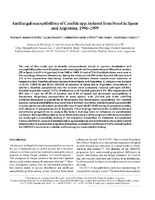Use este identificador para citar ou linkar para este item:
http://sgc.anlis.gob.ar/handle/123456789/359| Título: | Antifungal susceptibilities of Candida spp. isolated from blood in Spain and Argentina, 1996-1999 | Autor(es): | Cuenca-Estrella, Manuel Rodero, Laura Garcia-Effron, Guillermo Rodríguez-Tudela, Juan L. |
Palavras-chave: | Candida;Antifúngicos;España;Argentina;Resistencia a Medicamentos | Data do documento: | 2002 | Jornal: | The Journal of antimicrobial chemotherapy | Resumo: | The aim of this study was to identify retrospectively trends in species distribution and susceptibility patterns of Candida species causing bloodstream infections in 99 medical centres (55 in Spain and 44 in Argentina) from 1996 to 1999. A total of 744 Candida isolates were sent to the mycology reference laboratories during the study period (514 to the Spanish laboratory and 230 to the Argentinian laboratory). Candida non-albicans strains caused more episodes of fungaemia than Candida albicans isolates in both Spain and Argentina. C. albicans was isolated in 30.2% (155/514) and 40.9% (94/230) of episodes in Spain and in Argentina, respectively. In addition, Candida parapsilosis was the second most commonly isolated pathogen (36.4%). Candida tropicalis caused 13.7% of infections and Candida glabrata 7.4%. The amphotericin B MIC was less than or equal to1 mg/L for 97.5% of isolates, and 8.3% of strains had decreased susceptibility to flucytosine. Regarding susceptibility to azole agents, 9.9% (74/744) and 21.9% (163/744) exhibited decreased susceptibility to fluconazole and itraconazole, respectively. For Candida species, some marked differences were found between countries, and decreased susceptibility to azole agents was detected significantly more frequently (P < 0.05) among Argentinian isolates of C. albicans, C. parapsilosis and C. tropicalis. These findings reinforced the need for continued surveillance programmes to analyse the factors that may have an influence on candidaemia incidence. Susceptibility patterns were obtained by means of the proposed reference procedure for antifungal susceptibility testing of the European Committee on Antibiotic Susceptibility Testing (EUCAST). Excellent interlaboratory agreement was achieved for MICs for quality control strains noted in Spain and in Argentina (intraclass correlation coefficient of 0.97), indicating that the EUCAST procedure is a reliable methodology for susceptibility testing. |
Descrição: | Fil: Cuenca-Estrella, Manuel. Instituto de Salud Carlos III. Servicio de Micología; España. Fil: Rodero, Laura. ANLIS Dr.C.G.Malbrán. Instituto Nacional de Enfermedades Infecciosas. Departamento de Micología; Argentina. Fil: Garcia-Effron, Guillermo. ANLIS Dr.C.G.Malbrán. Instituto Nacional de Enfermedades Infecciosas. Departamento de Micología; Argentina. Fil: Rodriguez-Tudela, Juan L. Instituto de Salud Carlos III. Servicio de Micología; España. |
URI: | http://sgc.anlis.gob.ar/handle/123456789/359 http://jac.oxfordjournals.org/content/49/6/981.full.pdf+html?sid=b5edda98-f3fa-4841-910c-d19128e4352a |
ISSN: | 1460-2091 | Direitos: | 2003-03-14 info:eu-repo/semantics/embargoedAccess Open Access Creative Commons Attribution 4.0 International License |
| Aparece nas Coleções: | snrd Publicaciones INEI |
Arquivos neste item:
| Arquivo | Descrição | Tamanho | Formato | |
|---|---|---|---|---|
| Cuenca_Estela_M_Antifungalsuceptibilities.pdf | 1.93 MB | Adobe PDF |  Ver/Aberto |
Visualização de página
195
Checado em 13/12/2025
Download(s)
112
Checado em 13/12/2025
Google ScholarTM
Checar
Este item está licenciada sob uma Licença Creative Commons


